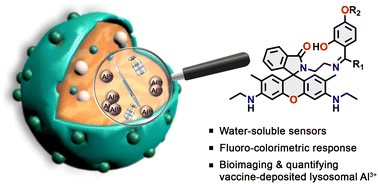Trivalent metal ion sensor enabled bioimaging and quantification of vaccine-deposited Al3+ in lysosomes†
Abstract
Extracellular metallic debris is deposited into the well-known ‘recycle bins’ of the cells named lysosomes. The accumulation of unwanted metal ions can cause dysfunction of hydrolyzing enzymes and membrane rupturing. Thus, herein, we synthesized rhodamine-acetophenone/benzaldehyde derivatives for the detection of trivalent metal ions in aqueous media. In solution, the synthesized probes exhibited a ‘turn-on’ colorimetric and fluorometric response upon complexation with trivalent metal ions (M3+). Mechanistically, M3+ chelation enables the appearance of a new emission band at approximately 550 nm, which verifies the disruption of the closed ring and the restoration of conjugation on the xanthene core in rhodamine 6G derivatives. Exclusive localization of the biocompatible probes at the lysosomal compartment favored the quantification of deposited Al3+. Moreover, the novelty of the work lies in the detection of Al3+ deposited in the lysosome that originated from hepatitis B vaccines, which shows their efficiency for near future in vivo applications.

- This article is part of the themed collection: Analyst HOT Articles 2023


 Please wait while we load your content...
Please wait while we load your content...